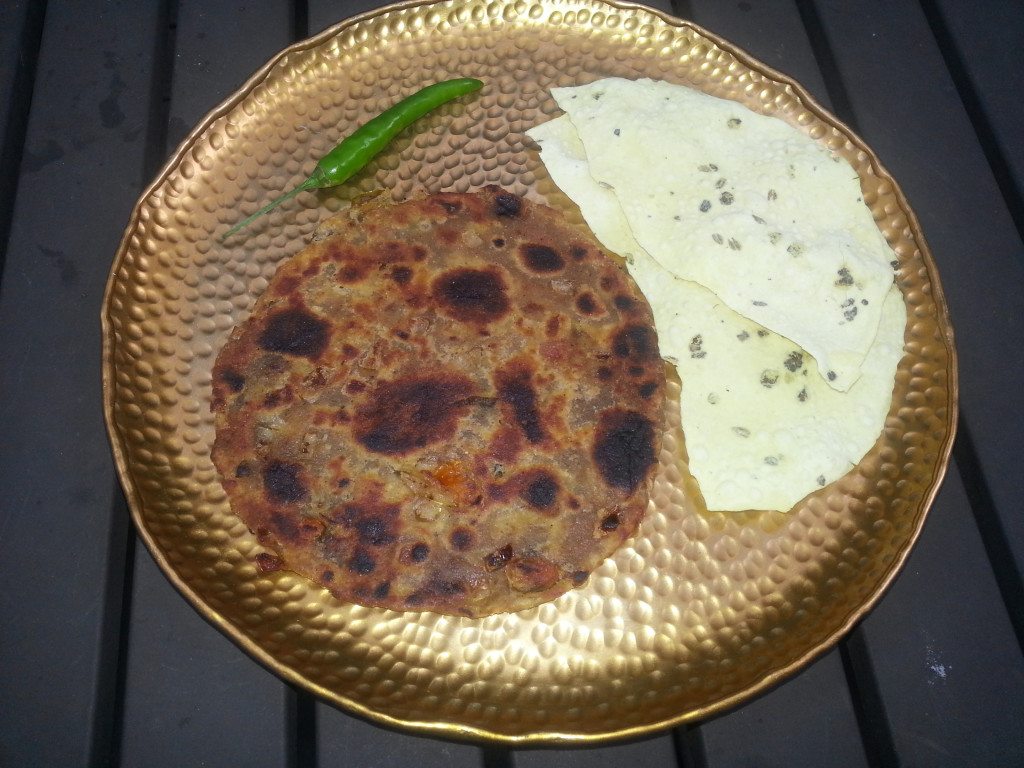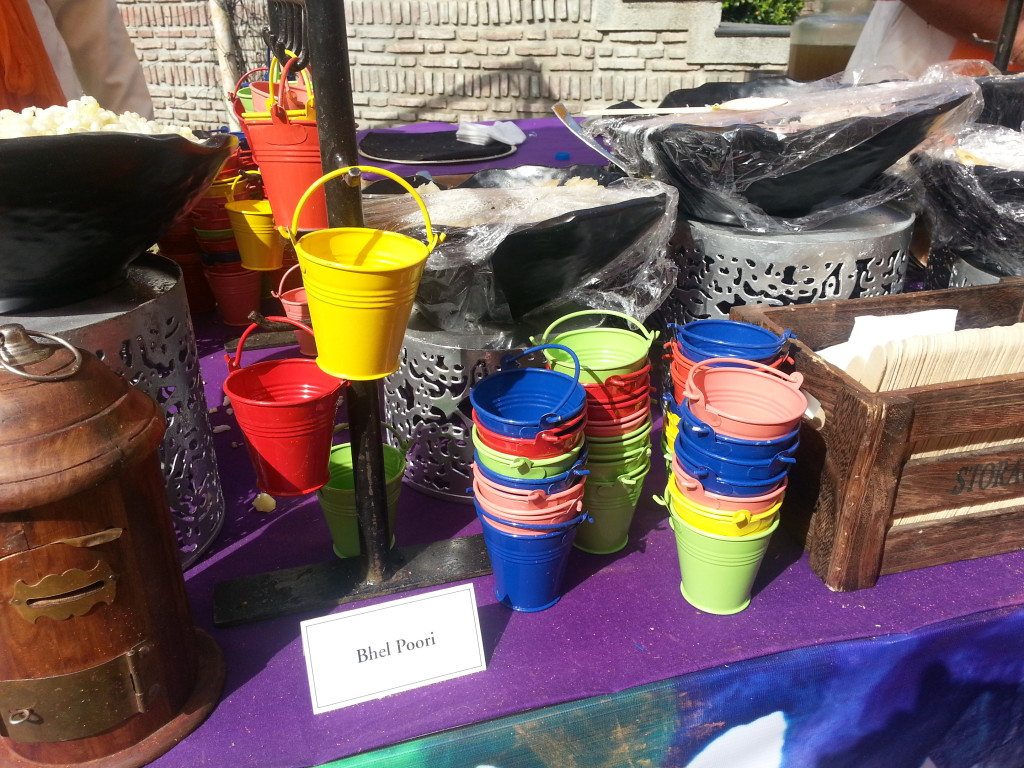15,616 people reached on Lassi with Lavina FB page
Ann vix, Sheila Shahani, Sandhya G Panjwani and Meera Narasimhan like it on Lassi with Lavina FB page
3084 views on LinkedIn – 50 LIkes – 15 comments
199 people reached on Instagram – 19 Likes

As I plan a fresh trip to India, I share with you a vegetarian journey before COVID, of food shared with friends and strangers.
My Vegetarian Journey into Delhi
[dropcap]I[/dropcap]n India, it’s all about food – and if you’re vegetarian, India simply has no comparison. As a traveler from the prosaic west and eater of quick sandwich meals, my return journey to Delhi, the capital of India, brought me to the fabled magic table of remembered childhood where you have to merely clap your hands to get unimagined delicacies. No mere salad, pizza or boiled veggies here – the complex dishes which appear on the dining table are deliciously intricate, from Ghatte Ke Curry (Rajasthan) to Besan Koftas in Yogurt (Punjab) to Vegetarian Keeme ka Lola (Sindh).
As a toddler, I remember our family cook Shankar who used to work on a coal sigri in the open courtyard and hand-feed us hot, simple sabzis with hot rotis, as he told us stories from the Ramayana. Those tastes linger after decades, as does the taste of Sindhi channa dabalroti – chickpeas simmered in a golden gravy made from besan or chick pea flour and served over slices of white bread, with a topping of sliced onions and ‘murmulas’. This was served to friends who came to our home to view the grand Republic Day Parade which passed from below the balcony of our apartment in Connaught Place every year.
Yes, food was always an intrinsic part of our outings – be it plates of alu tikkis or aromatic chole bhature and plump, syrupy gulab jamuns at roadside stalls. Delhi is famous for its chaat shops and every residential market has these fiery ammunition centers to scorch your tongue and make you weep with spicy delight with pani puri, bhelpuri, gol gappas, and samosa chaat.


[dropcap]T[/dropcap]hen there were the visits to Old Delhi which was my father’s go-to destination for a special hundred percent pure pista mithai which I craved as a child. Seems at the age of four, I was a finicky eater and would eat only this dark green rich pistachio sweet and my dad would often drive all the way to the old city to get it for me.
If happy occasions involved food so did sad ones. There was the season of shraddas – meals commemorating the departed – and carloads of uncles, aunts and cousins would descend on the home for prayers and feeding the pujari the delicious treats the ancestors had loved and then we too would feast on the wonderful food. There was Sindhi curry and rice, saibhaji – spinach cooked with seven different vegetables, pakoras and samosas, daibhallas and of course all topped by syrupy gulab jamun and jalebis. The extended family would also bring their special dishes and it would be an endless talkathon and eatathon. With so many uncles and aunts around, life meant a lot of feasting after the fasting of holy days.

[dropcap]S[/dropcap]o I returned this year to an India exploding with food memories. The very first morning in Delhi at my sister’s home it was as if nothing had changed; we had Sindhi kokies for breakfast, flatbreads embedded with chopped onions and green chilies, and served with yogurt. It was hard to stop at one, and it brought back memories of mothers and grandmothers, loved aunts – all of whom had on occasion served us this must-have breakfast.
As the families have grown with children married into different households from different regions of India, new recipes have entered into the repertoire, as well as western dishes which have become so popular in affluent India. On the menu might be a noodle dish one night and a Thai soup the next, while pizza and pastas are almost a part of the usual food at home. We also visited a sister-in-law who is Sindhi but grew up in Indonesia and made us a dinner of gado-gado, noodles, nasi goring and other treats – all hundred percent vegetarian since she is a Sai follower.



[dropcap]P[/dropcap]erhaps the greatest treats were the ones which were served at home, day in and day out by the family cook. Chillas made out of mung daal and served with guar and achari aloos. These crepes, somewhat like dosas, were unique in their flavor and tasted delicious with chutney. My sister had different food for me on the table every day including that made by a Brahmin cook who makes only vegetarian food without garlic or ginger.
Since everyone in my extended family circle has access to great cooks, there was a lot of animated food exchange going on between the families. Dahi ki sabzi is one of those unique tastes I had never experienced – made of thick, Greek-style yogurt, the dish has yogurt as the main ingredient with added condiments. Another unusual dish was tawe wale chawal – almost like a vegetarian biryani, using grams or lentils as the carbs/protein with its rich biryani flavoring.

[dropcap]I[/dropcap]n India, if money is not a concern then just about anything is possible, with a buzzing world of five-star hotels with the most elegant restaurants. I visited a fancy new restaurant called Delhi Club House – which is a take on famous old clubs like Calcutta’s Tollygunge Club and the Royal Bombay Yacht Club and their signature dishes. The menu includes many famous delicacies like cheese Bombay toastie (Presidency Club), vegetable momos (Gorkha Rifles Mess), and Saffron Onion Rice (Railway Club).
The mall culture provides lots of fancy restaurants as well as fast food places. The brand names from America are all there from Subway to Dominos to TGIF . McDonalds, for instance, offers varied vegetarian alternatives which you would not find in America’s fast food scene, such as Mexican and Lebanese McAloo Tikki, Crispy veggie pops and Paneer Salsa Wrap.

[dropcap]I[/dropcap]f America has brought Burger King to India, an enterprising trio have come up with – Burger Singh! These are craft burgers with a sense of humor and a definite Indian touch. The vegetarian burger eaters also have a diverse menu starting with Nani’s Rajma Burger (Grandma’s bean burger ), United States of Punjab Veg Burger, Chana Burger (Chick peas burger) and Shorshe Paneer Burger (made with Bengali flavors).
Even middle class India is on a big eating out journey – there are small restaurants everywhere and many like Haldirams provides good, hygienic food at a good price. These tasty delights are street food in a sanitized atmosphere, handled with gloves and with chutneys made with bottled water – no risk of Delhi belly here!

[dropcap]D[/dropcap]elhi has scores of restaurants with regional cuisine from Gujarati to South Indian. Swagath in the Defence Colony Market has the most marvelous dosas and south Indian food and a big screen TV to enjoy the cricket games when cricket fever hits. The restaurant which has 7 chain eateries serves Mangalorean, Malvani, Goan, Chettinad, Gomantak and Andhra cuisine. In Delhi you can get everything from Bengali to Tibetan cuisine, and with many vegetarian variations.
Vegetarians are in the majority in India so are treated special – even Chinese and Thai food has a strong vegetarian component to the menu. Restaurants are so aware of the veggie consumers’ needs that the menu for Berco’s, a Chinese and Thai restaurant in Delhi, clearly states “All dishes can be made without onions and garlic – just let us know!”
[dropcap]D[/dropcap]uring my 45 day stay in India, I probably ate every possible kind of meal, from gourmet to street-food to home cooked comfort food. What stays in my memory is a grand Holi celebration at a friend’s house where all the food was created by traditional chefs from Mathura, home of Lord Krishna. Guests played with colors and danced to the music to celebrate the festival of colors. The hosts had created a colorful marketplace with a vegetarian feast of specialties from this pilgrimage spot, all served on metal plates and in clay pots.

[dropcap]T[/dropcap]he menu included everything from malpuras (sweet breads) to pakoras, vada pav and ragda pattis (snacks) to main courses including Paneer ki Khurchan and dessert of rich kulfis served in little clay pots. There were mounds of jalebis and multicolored mithai. Fresh puris made of green peas were being fried on the spot. The bhel puri was being served in playful little multicolored buckets, in keeping with the Holi spirit. It was like a Vegetarian Paradise with unimagined treats, and all cooked with pure ghee.
Yes, in India, if you can dream it – there are skilled hands that can make it happen!
(This article was first published in Hinduism Today )



6 Comments
In India, the water has to be boiled otherwise you’re in for Delhi Belly!
Deepak Sethi via Facebook
Are you OK eating chutney made with water that might not have been boiled? Just curious. Thanks
Meena, You have to be well-fed before you come into FB or you’re going to be very hungry!! Especially with posts about Delhi ka khana!
Meena Kashyap Parmasir via Facebook
Delicious!
Bollywood Haute Couture via Facebook
Gatte Ki Curry is my favorite!
Vegetarian Cooking community on Google Plus
To Live And Dine +1’d
Sylvia Brenton +1’d
Corporlish +1’d
Watch India Wide Community
Chandresh Maheta +1’d